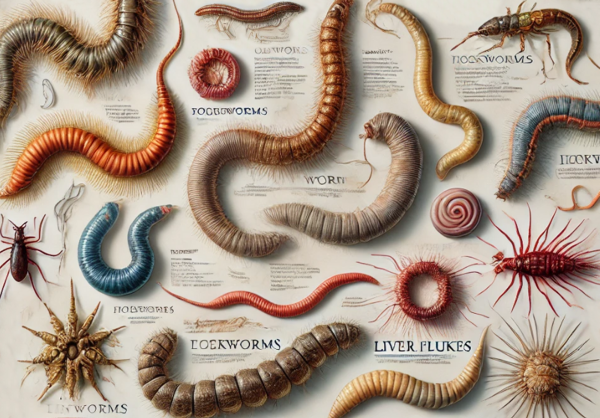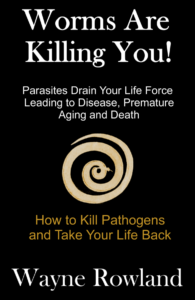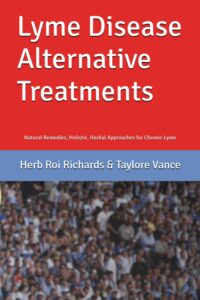Parasites are far more prevalent than most people realize. These tiny organisms inhabit the human body in numerous ways, often going undetected for years while subtly undermining health. Found in the intestines, blood, skin, and even internal organs, they can cause symptoms ranging from mild discomfort to life-threatening diseases.
The good news is that with greater awareness and understanding of these organisms, their effects, and available treatments, individuals can take proactive steps to safeguard their health.
What Are Parasites?
A parasite is an organism that lives in or on a host, deriving its nutrients at the host’s expense. Parasites can be classified into several types, including:
- Protozoa: Single-celled organisms that multiply within their host. Examples include Plasmodium (causing malaria) and Giardia (causing gastrointestinal distress).
- Helminths: Multicellular organisms, such as worms, that can inhabit various parts of the body.
- Ectoparasites: Organisms like lice, mites, and ticks that live on the skin.
- Spirochetes: Spiral-shaped bacteria that behave parasitically, causing diseases such as Lyme disease and syphilis.
How Parasites Enter the Body
Parasites enter the human body in numerous ways, including:
- Contaminated Food and Water: Unwashed produce, undercooked meat, and impure water are common transmission routes.
- Insect Bites: Mosquitoes, ticks, and sandflies can carry parasites that enter the bloodstream.
- Direct Contact: Skin parasites like scabies can be transmitted through prolonged physical contact.
- Poor Hygiene: Lack of handwashing after handling pets, soil, or contaminated objects increases exposure.
- Travel to Endemic Areas: Visiting regions with high parasitic prevalence exposes individuals to unfamiliar organisms.
Common Parasites and Their Effects
Parasitic Worms (Helminths)
Helminths can grow to significant sizes and cause profound health issues. Here are the most common types:
- Roundworms (Nematodes):
- Ascaris lumbricoides: Causes malnutrition, intestinal blockage, and respiratory distress, especially in children.
- Enterobius vermicularis (Pinworm): Common in children, pinworms cause itching, sleep disturbances, and irritability.
- Tapeworms (Cestodes):
- Taenia saginata: Contracted through undercooked beef, leading to malnutrition.
- Echinococcus granulosus: Forms cysts in organs, which can rupture and cause severe complications.
- Flukes (Trematodes):
- Schistosoma: Affects over 200 million people worldwide, leading to chronic illness and organ damage.
- Fasciola hepatica: A liver fluke causing bile duct obstruction and liver inflammation.
- Hookworms:
- These parasites penetrate the skin (often through bare feet) and migrate to the intestines, causing anemia, fatigue, and developmental delays.
Skin Parasites
These parasites target the skin, causing irritation and secondary infections:
- Scabies Mites: Burrow into the skin, resulting in intense itching and rashes.
- Lice: Affect the scalp, body, or pubic area, often causing itching and sores.
- Chiggers: Microscopic larvae that bite the skin, leading to red, itchy welts.
- Ticks: Not only cause skin irritation but can also transmit Lyme disease and other infections.
Blood-Borne Parasites
These parasites circulate in the bloodstream and cause systemic diseases:
- Plasmodium (Malaria): Leads to cycles of fever, chills, and potentially life-threatening complications.
- Trypanosoma cruzi (Chagas Disease): Damages the heart and digestive system over time.
- Leishmania: Causes disfiguring sores or systemic organ damage, depending on the species.
Spirochetes
These spiral-shaped bacteria can act as parasites, resulting in chronic conditions:
- Borrelia burgdorferi (Lyme Disease): Reportedly transmitted by ticks but highly contagious, it can cause joint pain, neurological symptoms, and chronic fatigue.
- Treponema pallidum (Syphilis): A sexually transmitted infection that can progress to affect the brain, heart, and other organs.
- Leptospira (Leptospirosis): Often contracted through water contaminated by animal urine, causing severe organ damage if untreated.
Something else to bear in mind is that all of a species’ different variations show similar behavior. Therefore, if one kind of spirochete can be sexually transmitted and further spread through close human interaction, all other forms of spirochetes could potentially be transmitted in the same way. This could explain the thousands of people with Lyme disease who a tick has never bitten.
The sad reality is that, due to the myth that Lyme disease can only be contracted through deer ticks, thousands of Lyme sufferers are being misdiagnosed and treated for conditions they do not have.
Signs and Symptoms of Parasitic Infections
Parasites can mimic other health conditions, making diagnosis challenging. Common signs include:
- Digestive issues: bloating, diarrhea, constipation, or abdominal pain.
- Fatigue and weakness: often linked to malnutrition or anemia caused by parasitic infections.
- Skin problems: rashes, itching, or sores.
- Unexplained weight changes: due to nutrient depletion.
- Behavioral changes: irritability, anxiety, or depression, potentially linked to toxins released by parasites.
- Chronic illnesses: persistent infections may exacerbate autoimmune conditions or systemic inflammation.
Conventional and Natural Treatments
There are numerous antiparasitic options available to address these persistent invaders, including both conventional medications and natural remedies.
1. Ivermectin
Initially developed for veterinary use, ivermectin is now widely prescribed for treating human parasitic infections such as scabies and river blindness. It works by paralyzing and eliminating parasites, reducing their presence in the body. Marketed under the brand name Stromectol, ivermectin is typically available in tablet form by prescription.
2. Fenbendazole
Fenbendazole is primarily used in veterinary medicine but has gained attention for its potential off-label use in humans. Known for its effectiveness against a variety of intestinal parasites, this medication is believed to help cleanse the digestive system of harmful organisms. However, its use in humans should be approached with caution and under medical supervision.
3. Pyrantel
Pyrantel is an antiparasitic medication effective against worms such as roundworms and pinworms. It is available in capsule and liquid forms and is typically administered as a single dose, offering a convenient and efficient solution for parasitic infections.
4. Food-Grade Diatomaceous Earth
This natural substance is often used as an internal cleanser and detoxifier. Food-grade diatomaceous earth helps adsorb toxins and expel parasites from the digestive system. It supports gut health while targeting opportunistic parasites, making it a popular choice in natural health circles.
5. Super Saturated Potassium Iodide (SSKI)
Super saturated potassium iodide (SSKI) can be taken orally or applied topically. Known for its ability to break down mucus in the airways, SSKI is often used to expel mucus and even lung parasites. It is especially beneficial for individuals with chronic respiratory conditions like asthma, chronic bronchitis, or emphysema, acting as a powerful expectorant to improve breathing.
6. Turpentine
Turpentine was the gold standard in the 1800s, and it was used in traditional medicine before the introduction of modern medicine’s patented pharmaceutical preparations. Turpentine is highly regarded for its antiparasitic properties, particularly in the treatment of myiasis (infestation of the body by fly larvae), though it is not authorized nor recommended by modern medical professionals.
7. Chlorine Dioxide (MMS)
Chlorine dioxide, sometimes referred to as MMS (Master Mineral Solution), has sparked considerable interest as a potential remedy for various infections, including parasitic ones. While its use is controversial, proponents suggest it supports the immune system and may help target bacteria, viruses, fungi, and parasites.
Chlorine Dioxide: Potential and Controversy
Origins and Applications
Chlorine dioxide gained popularity after being promoted by Jim Humble, who claimed it could cure malaria. Over time, it has been used as an alternative remedy for various conditions, including arthritis, herpes simplex, and infections caused by bacteria and molds. Some users have also reported its potential effectiveness against Morgellons disease and AIDS.
Preparation and Use
Chlorine dioxide is made by combining sodium chlorite with an acid activator in water, producing a compound known for its antimicrobial properties. A newer pre-mixed version, CDS 3000, simplifies preparation and aims to improve user experience despite the solution’s unpleasant taste.
Alternative Methods of Administration
Some users opt for unactivated sodium chlorite mixed with water, allowing stomach acid to activate the solution naturally. This method is believed to target infections more effectively in certain cases. Others prefer consuming the pre-activated solution, starting with one drop diluted in four ounces of water twice daily and gradually increasing the dosage.
Considerations and Precautions
It’s crucial to note that antioxidants and probiotics can neutralize chlorine dioxide, so users often separate their intake of supplements and vitamins from chlorine dioxide. Furthermore, individual responses to this treatment vary widely, and exceeding recommended doses can pose health risks.
Professional Guidance
Given its unregulated status and ongoing debates in medical circles, it is essential to consult with a natural healthcare professional before beginning any chlorine dioxide protocol. Careful experimentation and personalized adjustments are often necessary to determine an effective and safe regimen.
Natural Remedies
- Garlic: Contains compounds that kill parasites and support the immune system.
- Wormwood and Black Walnut: Traditionally used to expel intestinal worms.
- Cloves: Known for their antimicrobial properties.
- Pumpkin Seeds: Often consumed to paralyze and expel tapeworms.
- Neem: Used in Ayurvedic medicine to eliminate parasites and cleanse the blood.
- Montana Yew Tips: Used by indigenous cultures for antimicrobial and antiparasitic effects.
Historical and Indigenous Wisdom
Many traditional cultures have long used natural remedies for parasites. For example:
- Ancient Ayurvedic Practices: Neem and turmeric were staples in parasite cleansing.
- Indigenous North American Remedies: Pine, yew tips, and black walnut hulls were used to combat worms.
- Amazonian Traditions: Pau d’Arco bark served as an antimicrobial and antiparasitic agent.
Preventive Measures and Recovery Strategies
Prevention
- Hygiene: Wash hands, especially before eating or after handling pets.
- Food Safety: Cook meat thoroughly and wash produce.
- Protective Measures: Use insect repellents and wear protective clothing in parasite-prone areas.
Recovery
- Immune Support: Incorporate vitamins, antioxidants, and probiotics to rebuild health.
- Stress Management: Chronic stress weakens immunity—practice relaxation techniques.
- Hydration and Diet: Stay hydrated and maintain a nutrient-rich diet to support detoxification.
Environmental Hygiene
- Clean Living Spaces: Regularly vacuum, dust, and sanitize areas to eliminate parasites.
- Proper Waste Disposal: Ensure safe disposal of waste to reduce contamination risks.
- Insect Control: Install window screens and use repellents to prevent parasite-carrying insects.
Moving On
While parasites may be a natural part of life, they don’t have to dictate your health. By combining conventional medicine, natural remedies, and preventive measures, individuals can minimize their impact. Remember, early detection and treatment are key to avoiding long-term complications. Always consult healthcare professionals before starting any treatment, especially with natural or unconventional methods.
Taking control of your health starts with awareness—and the knowledge to act effectively against these hidden invaders.
Resources:
1. Centers for Disease Control and Prevention (CDC)
- General information on parasites, their transmission, and prevention strategies.
2. World Health Organization (WHO)
- Overview of parasitic diseases, including schistosomiasis and lymphatic filariasis.
3. WebMD
- Information on Super Saturated Potassium Iodide (SSKI) and its applications for lung conditions and parasites.
4. National Institutes of Health (NIH)
- Research on herbal remedies, including wormwood, cloves, and black walnut for parasitic infections.
5. National Center for Biotechnology Information (NCBI)
- Studies on garlic and its antimicrobial properties against parasites.
6. The Merck Veterinary Manual
- Details on veterinary uses of fenbendazole and ivermectin, with information on human off-label applications.
7. Lyme Disease Alternative Treatments
- Documentation efforts resulting from Chronic Lyme conferences, including natural remedies, holistic and herbal approaches.
8. The Master Mineral Solution of the Third Millennium
- Jim Humble’s background on chlorine dioxide (MMS) and its reported uses.
9. Healthy Alternative Chlorine Dioxide Uses
- Paris Humble’s guide manual for non-pharmacological health restoration.
10. Worms Are Killing You!
- Disclosure regarding parasites and parasitic worms, including parasite cleanse and deworming regimens by Wayne Rowland.
11. Natural Medicine Journal
- Discussion of antiparasitic herbs like neem, turmeric, and berberine in integrative medicine.
12. Journal of Parasitology
- Research articles on the lifecycle and effects of parasites like hookworms and Ascaris lumbricoides.
13. Johns Hopkins Medicine
- Guidelines on recognizing and treating skin parasites such as scabies and lice.
14. Herbal Medicine: Biomolecular and Clinical Aspects (2nd edition)
- Discussion on traditional uses of medicinal plants like mugwort, goldenseal, and olive leaf extract.
15. Global Healing Center
- Uses of diatomaceous earth and other natural remedies for internal cleansing.
16. Environmental Protection Agency (EPA)
- Best practices for insect control and safe waste disposal to reduce exposure to parasites.
17. How to Guide for Parasites and Parasitic Worms Manual
- Quick reference addendum for studies and presentations regarding parasitology.




